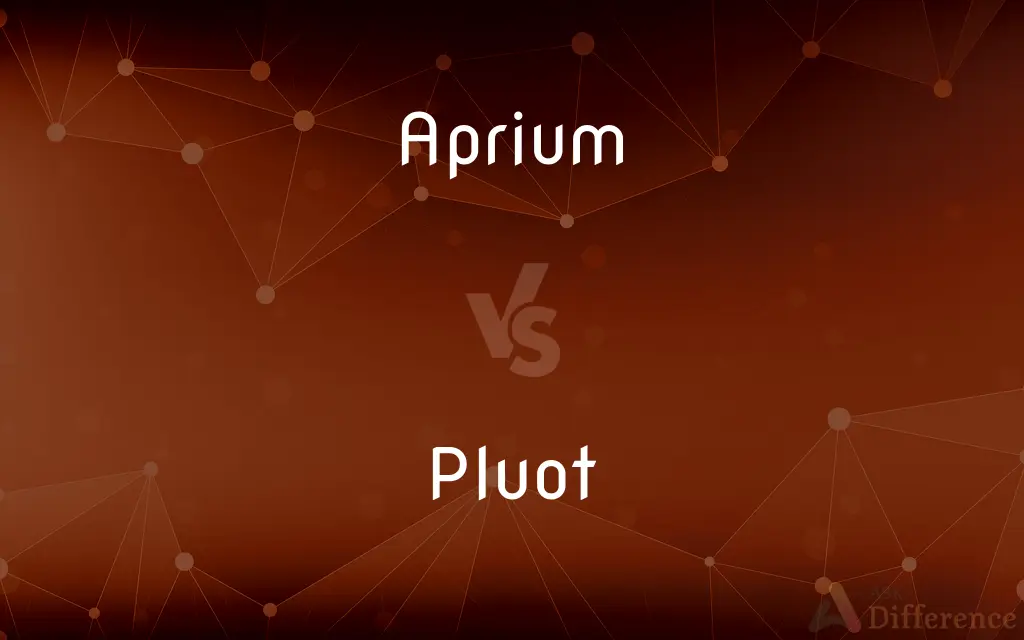Aprium vs. Pluot — What's the Difference?
By Tayyaba Rehman & Urooj Arif — Updated on April 25, 2024
Apriums (75% apricot, 25% plum) have a dense texture and sweet flavor, while pluots (75% plum, 25% apricot) are juicy with a tangy-sweet taste, both being apricot-plum hybrids.

Difference Between Aprium and Pluot
Table of Contents
ADVERTISEMENT
Key Differences
Apriums resemble apricots in their appearance and have a dense, smooth texture. They are primarily sweet with a slight tartness, characteristic of their apricot dominance. On the other hand, pluots have a more noticeable plum influence, reflected in their plump appearance and juicier, more fibrous texture. They often display a balance between sweetness and a tangy undertone.
The flavor profile of apriums is heavily skewed towards apricots, making them sweeter and less complex than pluots. In contrast, pluots can vary more in flavor due to the diversity of plums used in their breeding, offering a wider range of tastes from sweet to tart.
In cultivation, apriums are typically harvested earlier in the season, aligning more closely with apricot harvest times. Pluots have a longer harvesting period that tends to overlap more with plum seasons, offering greater flexibility in cultivation and market availability.
Apriums are generally more resistant to diseases typical to apricots thanks to their plum genetic contribution, yet they maintain a strong apricot flavor and color. Pluots, while inheriting disease resistance from both parent fruits, showcase a greater variety of skin colors and patterns, reflective of the diverse plum species in their lineage.
Apriums are often preferred for their intense apricot flavor and are particularly suited for fresh eating and desserts that benefit from a firmer texture. Pluots, with their juicier and tangier profile, are versatile in both fresh consumption and in cooking, where their moisture and flavor can enhance a variety of dishes.
ADVERTISEMENT
Comparison Chart
Dominant Fruit
Apricot (75%)
Plum (75%)
Texture
Dense and smooth
Juicy and fibrous
Flavor
Sweet with mild tartness
Tangy-sweet, varies from sweet to tart
Harvest Time
Earlier in the season
Overlaps with plum season
Uses
Fresh eating, desserts
Fresh eating, cooking, desserts
Compare with Definitions
Aprium
Dense and smooth texture.
Apriums are firm enough to hold up well in fruit salads.
Pluot
Juicy and fibrous texture.
The fibrous nature of pluots adds a nice bite to smoothies.
Aprium
A hybrid fruit dominated by apricot traits.
The aprium, with its sweet flavor, is perfect for making jam.
Pluot
Versatile in both raw and cooked forms.
Pluots can be grilled for desserts or chopped into salsas for a tangy twist.
Aprium
Higher apricot genetic content.
Apriums have the vibrant orange color typical of apricots.
Pluot
Greater plum influence in genetics.
The pluot's skin showcases the mottled patterns typical of many plum varieties.
Aprium
Sweet with a slight tartness.
The subtle tartness of the aprium complements its overwhelming sweetness.
Pluot
Flavor ranges from sweet to tart.
Depending on the variety, a pluot can taste sweet with a tangy finish.
Aprium
Primarily used fresh or in desserts.
Apriums make excellent additions to pastry fillings due to their texture and sweetness.
Pluot
A plum-dominant hybrid fruit.
Pluots have a juicy texture that makes them a refreshing snack in the summer.
Aprium
(neologism) A plum-apricot cross, with characteristics of both fruits.
Pluot
A hybrid fruit that is a cross between a plum and an apricot and is typically three-quarters plum and one-quarter apricot.
Pluot
Pluots, apriums, apriplums, or plumcots, are some of the hybrids between different Prunus species that are also called interspecific plums. Whereas plumcots and apriplums are first-generation hybrids between a plum parent (P. salicina) and an apricot (P. armeniaca), pluots and apriums are later-generations.
Pluot
A fruit which is a cross between a Japanese plum and an apricot, featuring more characteristics of plums than those of apricots.
Common Curiosities
Can apriums and pluots be used interchangeably in recipes?
While they can sometimes be substituted for each other, their differing moisture and flavor profiles may affect the outcome of recipes.
What is the peak season for apriums and pluots?
Apriums are typically harvested in late spring to early summer, while pluots are available from mid-summer to early fall.
Are apriums or pluots more popular in culinary uses?
Pluots tend to be more popular in culinary uses due to their moisture content and flavor complexity, making them more versatile.
ow were apriums and pluots developed?
Apriums and pluots were developed through selective breeding techniques, crossing different varieties of apricots and plums to achieve desired traits.
Are there any notable nutritional differences between apriums and pluots?
Nutritional differences are minor, with both providing a good source of vitamins, particularly Vitamin C and dietary fiber.
What are the best conditions for growing apriums and pluots?
Both apriums and pluots thrive in climates similar to their parent fruits, requiring well-drained soil and plenty of sunlight.
How should apriums and pluots be stored for best freshness?
Both should be stored at room temperature until ripe and then refrigerated to prolong freshness.
Can you grow apriums and pluots from seed?
Growing these hybrids from seed may not produce fruit true to the parent due to their complex genetics, so it is recommended to propagate through grafting.
Which is sweeter, an aprium or a pluot?
Generally, apriums are sweeter due to their higher apricot content, while pluots can vary more in sweetness due to the diversity of plums.
What are some popular varieties of apriums and pluots?
Popular aprium varieties include 'Flavor Delight' and 'Cot-N-Candy', while pluot varieties include 'Dapple Dandy' and 'Flavor King'.
How do apriums and pluots contribute to biodiversity?
These hybrids contribute to agricultural biodiversity by combining traits from different species, offering variety in diets and cultivation.
What challenges might growers face with apriums and pluots?
Growers may face challenges related to pollination and climate suitability, as these hybrids require specific conditions to produce fruit.
What makes apriums and pluots special in the fruit market?
Their unique flavors and textures make apriums and pluots special in the market, appealing to consumers looking for something different from standard apricots and plums.
Do apriums ripen after being picked?
Yes, apriums can ripen after being picked, softening and becoming sweeter over time.
Are there any pest concerns specific to apriums or pluots?
Like their parent fruits, apriums and pluots are susceptible to common pests like aphids and plum curculio.
Share Your Discovery

Previous Comparison
Turgid vs. Flaccid
Next Comparison
Collect vs. ReceiveAuthor Spotlight
Written by
Tayyaba RehmanTayyaba Rehman is a distinguished writer, currently serving as a primary contributor to askdifference.com. As a researcher in semantics and etymology, Tayyaba's passion for the complexity of languages and their distinctions has found a perfect home on the platform. Tayyaba delves into the intricacies of language, distinguishing between commonly confused words and phrases, thereby providing clarity for readers worldwide.
Co-written by
Urooj ArifUrooj is a skilled content writer at Ask Difference, known for her exceptional ability to simplify complex topics into engaging and informative content. With a passion for research and a flair for clear, concise writing, she consistently delivers articles that resonate with our diverse audience.
















































